The construction industry is undergoing a significant transformation with the advent of Fully Volumetric Modular Offsite Construction. This innovative approach is revolutionizing the way buildings are designed and constructed, addressing pressing challenges like affordability, efficiency, and sustainability.
Innovative modular construction methods are opening doors to groundbreaking advancements, making it possible to deliver high-quality buildings at a lower cost and with reduced environmental impact.
Key Takeaways
- Innovative modular construction is transforming the building industry.
- Modular construction engineering offers numerous benefits, including affordability and sustainability.
- Fully Volumetric Modular Offsite Construction is a game-changer in the construction sector.
- This approach reduces environmental impact while maintaining high-quality standards.
- Efficient and cost-effective, modular construction is the future of building.
What is Modular Construction Engineering?
Modular construction engineering represents a significant shift in how buildings are designed, constructed, and delivered. This innovative approach involves fabricating modules in a controlled factory setting, which are then assembled on-site.
Definition of Modular Construction
Modular construction is a process where building components, or modules, are manufactured in a factory and then transported to the construction site for assembly. This method allows for parallel on-site work, enabling faster project completion and earlier occupancy. By minimizing weather-related delays, modular construction engineering offers a more efficient and reliable alternative to traditional construction methods.
Key Elements of Modular Engineering
The key elements of modular engineering include design flexibility, precision manufacturing, and efficient assembly. Modular construction methods allow for a high degree of customization, enabling architects and builders to create complex designs that meet specific project requirements. Precision manufacturing ensures that modules are built to exacting standards, reducing the risk of on-site errors.
Some of the key benefits of modular construction engineering include:
- Reduced construction time
- Increased quality control
- Improved safety
- Enhanced sustainability
By leveraging these advantages, modular construction engineering is poised to play a significant role in shaping the future of the construction industry.
Benefits of Modular Construction Engineering
Modular construction engineering offers numerous benefits that are transforming the building industry. By leveraging advanced manufacturing techniques and streamlined processes, modular construction provides a more efficient, sustainable, and cost-effective alternative to traditional building methods.
Cost-Effectiveness
One of the primary advantages of modular construction is its cost-effectiveness. By standardizing processes and materials, modular construction reduces material waste and disposal costs, leading to more accurate cost estimates. According to a study by the Modular Building Institute, modular construction can result in cost savings of up to 20% compared to traditional construction methods.
| Cost Component | Traditional Construction | Modular Construction |
|---|---|---|
| Material Costs | $100,000 | $80,000 |
| Labor Costs | $150,000 | $120,000 |
| Total Cost | $250,000 | $200,000 |
Time Efficiency
Modular construction is also renowned for its time efficiency. By manufacturing modules in a controlled factory environment, construction can occur simultaneously with site preparation, significantly reducing the overall project timeline. As noted by a leading industry expert, “Modular construction can cut project timelines by up to 50%.” This is particularly beneficial for projects with tight deadlines.
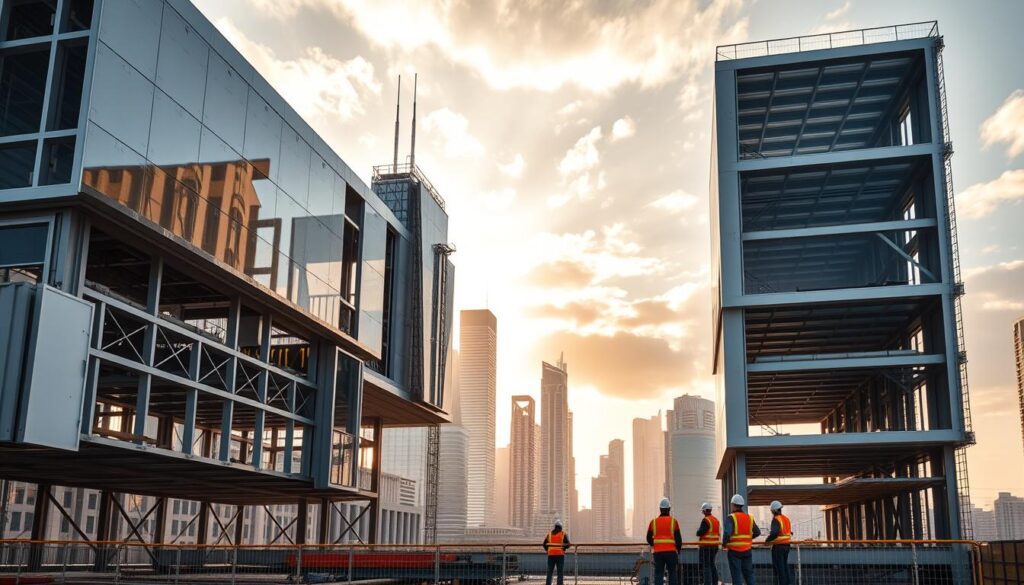
Sustainability Practices
Sustainability practices are another key benefit of modular construction. The controlled manufacturing environment allows for more efficient use of materials and energy, reducing the environmental footprint of the construction process. Additionally, modular construction generates less waste and can incorporate recycled materials, further enhancing its sustainability credentials.
“Modular construction is not just about building faster; it’s about building better, with a focus on sustainability and reduced environmental impact.”
Flexibility in Design
Finally, modular construction offers flexibility in design, allowing for a wide range of architectural styles and configurations. This flexibility enables architects and builders to create innovative, customized solutions that meet specific project requirements. Whether it’s for residential, commercial, or industrial applications, modular construction can accommodate diverse design needs.
- Customizable layouts
- Innovative architectural designs
- Adaptability to different building types
In conclusion, the benefits of modular construction engineering are multifaceted, encompassing cost-effectiveness, time efficiency, sustainability practices, and flexibility in design. As the construction industry continues to evolve, modular construction is poised to play an increasingly important role in shaping the built environment.
The Process of Modular Construction
The process of modular construction involves several critical stages that ensure the successful completion of a project. From initial planning to final installation, each stage plays a vital role in delivering a high-quality, modular building.
Planning and Design Stages
The first stage in modular construction is the planning and design phase. During this stage, architects and engineers work together to create a detailed design that meets the client’s requirements. This involves using advanced software, such as Building Information Modeling (BIM), to create a precise digital model of the building.
The design phase also includes selecting materials, determining the structural integrity of the building, and ensuring compliance with local building codes and regulations.
Manufacturing and Assembly
Once the design is complete, the manufacturing process begins. Modular units are constructed in a factory, where they are assembled using off-site construction technology. This controlled environment allows for greater precision and quality control, reducing the risk of errors and delays.
The modular units are then prepared for transportation to the construction site, where they will be assembled into the final structure.
Transportation and Installation
The transportation and installation stage is critical to the success of a modular construction project. Specialized transportation companies deliver the modular units to the site, where they are installed using cranes and other heavy machinery.
The installation process requires careful planning to ensure that the units are properly aligned and secured, forming a sturdy and cohesive structure.
| Stage | Description | Key Activities |
|---|---|---|
| Planning and Design | Creating a detailed design and plan | Using BIM software, selecting materials, ensuring compliance with regulations |
| Manufacturing and Assembly | Constructing modular units in a factory | Assembling units using off-site construction technology, quality control |
| Transportation and Installation | Delivering and installing modular units on-site | Transporting units, installing using cranes and heavy machinery |
In conclusion, the process of modular construction is a complex, multi-stage process that requires careful planning, precise manufacturing, and careful installation. By understanding these stages, builders and clients can better appreciate the benefits and challenges of modular construction methods.
Key Players in Modular Construction
As the demand for efficient and sustainable building solutions grows, key players in modular construction are stepping up to meet the challenge. These industry leaders are driving innovation and pushing the boundaries of what is possible with modular design and construction.
Leading Companies in the Industry
Several companies are at the forefront of modular construction, bringing years of experience and expertise to the table. Companies like EVstudio and Innovative Building Solutions are leading the way with their innovative approaches to modular construction. They are not only improving the efficiency of the construction process but also enhancing the quality of the final product.
For a comprehensive list of top modular construction companies, you can visit this page, which highlights the industry’s best.
| Company Name | Specialization | Notable Projects |
|---|---|---|
| EVstudio | Modular Design and Construction | Residential and Commercial Buildings |
| Innovative Building Solutions | Prefabricated Modular Construction | Educational and Healthcare Facilities |
| Modular Construction Inc. | Modular Building Solutions | High-Rise Buildings and Disaster Relief Housing |
Innovative Startups to Watch
In addition to established companies, innovative startups are also making significant contributions to the modular construction industry. These startups are bringing fresh perspectives and new technologies to the table, further advancing the field.
Some of the startups to watch include those that are leveraging technologies like 3D printing and Building Information Modeling (BIM) to improve modular construction processes.
Notable Projects and Case Studies
Several notable projects have showcased the potential of modular construction. From high-rise buildings to disaster relief housing, these projects demonstrate the versatility and efficiency of modular construction methods.
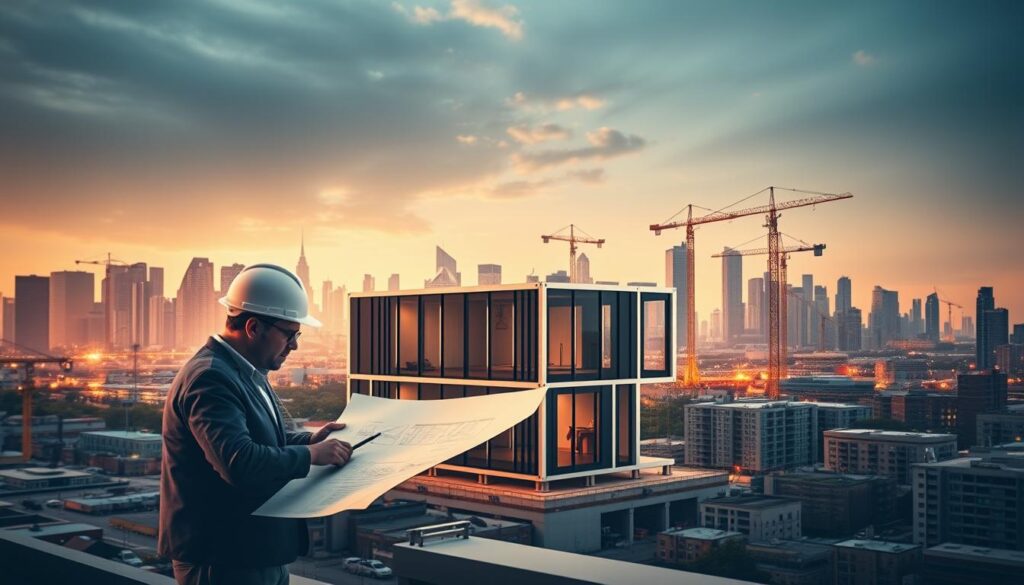
Case studies of these projects provide valuable insights into the benefits and challenges of modular construction, helping to inform future projects and drive further innovation in the industry.
Types of Modular Construction
Modular construction is not a one-size-fits-all solution; it comes in several forms, including permanent, relocatable, and hybrid modular constructions. This diversity allows modular construction to cater to a wide range of projects, from residential buildings to complex commercial spaces.
Permanent Modular Buildings
Permanent modular buildings are constructed to be permanent fixtures, often used in residential, educational, and healthcare facilities. These structures are built in a factory, transported to the site, and assembled on a foundation. The benefits of permanent modular buildings include reduced construction time and improved quality control, as the factory setting allows for more precise construction techniques.
Relocatable Modular Structures
Relocatable modular structures are designed to be moved or reconfigured as needed. They are commonly used for temporary offices, classrooms, or healthcare facilities during emergencies. The flexibility of relocatable modular structures makes them an attractive option for projects with changing requirements. For more insights on cost-effective construction methods, visit cutting construction costs.
Hybrid Modular Solutions
Hybrid modular solutions combine traditional construction methods with modular techniques. This approach allows for the flexibility to incorporate modular components into a traditionally built structure or vice versa. Hybrid modular solutions are particularly useful for complex projects that require a mix of construction techniques, enabling builders to leverage the benefits of both methods.
In conclusion, the different types of modular construction offer a range of benefits and applications, from the permanence of modular buildings to the flexibility of relocatable structures and the versatility of hybrid solutions. Understanding these types is crucial for selecting the most appropriate modular construction method for a specific project.
Modular Construction vs. Traditional Construction
Modular construction has revolutionized the building industry by offering a faster, more efficient, and environmentally friendly alternative to traditional construction methods. As the industry continues to evolve, understanding the differences between these two approaches is crucial for developers, architects, and clients alike.
Speed of Construction
One of the most significant advantages of modular construction is its ability to accelerate the building process. By manufacturing modules in a controlled factory environment, construction can occur simultaneously with site preparation, reducing overall project timelines. For instance, modular construction can cut the construction time by up to 50% compared to traditional methods. This speed of construction is particularly beneficial for projects with tight deadlines or those located in areas with harsh weather conditions.
Quality Control
Modular construction also excels in terms of quality control. The factory setting allows for rigorous inspection and testing protocols, ensuring that each module meets high standards of quality and durability. This controlled environment minimizes the risk of errors and defects commonly associated with traditional on-site construction. Furthermore, the use of advanced manufacturing technologies and skilled labor enhances the overall quality of the modules.
Environmental Impact
The environmental impact of modular construction is another area where it outperforms traditional methods. By reducing the amount of waste generated during construction and optimizing material usage, modular construction contributes to more sustainable building practices. Additionally, the ability to construct modules in a factory reduces the need for on-site equipment and vehicles, thereby lowering emissions and minimizing the project’s carbon footprint. For more insights on the comparison between modular and traditional construction, visit Delphi Construction’s article on the topic.
In conclusion, modular construction offers several key benefits over traditional construction, including faster construction times, improved quality control, and reduced environmental impact. As the construction industry continues to adopt modular techniques, it is likely that we will see further innovations and improvements in these areas.
Applications of Modular Construction Engineering
The versatility of modular construction is evident in its wide range of applications. Modular construction engineering is not limited to a single type of building; it encompasses a broad spectrum of structures that cater to different needs and industries.
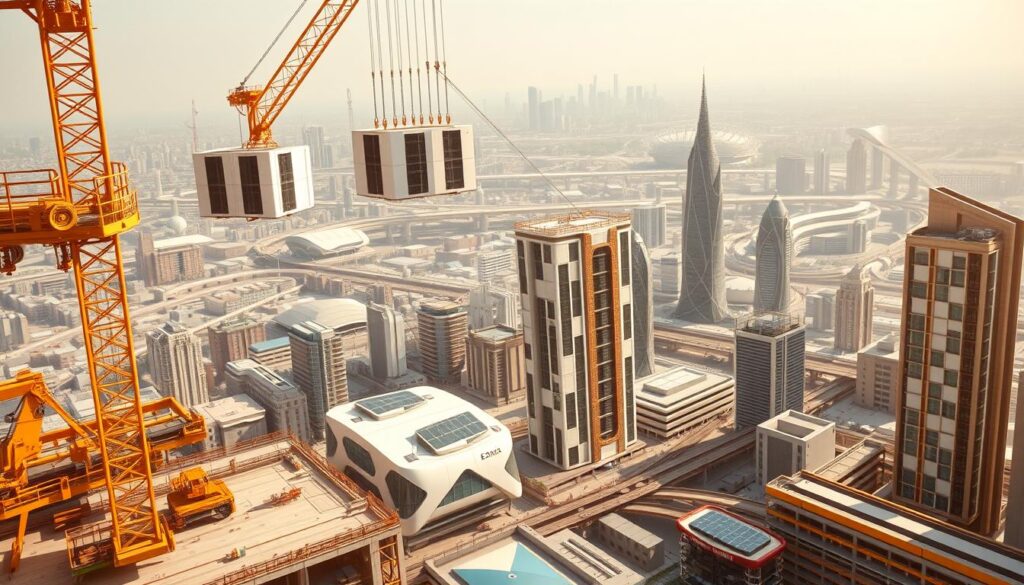
Residential Buildings
Modular construction has revolutionized the residential building sector by offering efficient and cost-effective housing solutions. Modular homes are built in a factory, transported to the site, and assembled, reducing on-site construction time. This method also allows for greater quality control and flexibility in design.
Commercial Spaces
In the commercial sector, modular construction is used for offices, retail spaces, and hotels. The speed of construction and minimal disruption to surrounding areas make it an attractive option for businesses looking to establish or expand their presence quickly.
Healthcare Facilities
Modular construction is particularly beneficial for healthcare facilities, where cleanliness and infection control are paramount. Modular units can be designed to meet stringent healthcare standards, and their off-site construction minimizes the risk of on-site contamination.
Educational Institutions
Educational institutions, such as schools and universities, benefit from modular construction through the rapid provision of additional classrooms and facilities. This method supports the timely delivery of educational infrastructure, adapting to changing student numbers and curriculum requirements.
In conclusion, the applications of modular construction engineering are diverse and continue to expand into various sectors. Its benefits, including efficiency, quality control, and flexibility, make it a preferred choice for many building projects.
Challenges in Modular Construction
Modular construction faces a multitude of challenges that can be broadly categorized into regulatory, logistical, and design-related issues. Despite its advantages, the industry must navigate through these challenges to achieve continued growth and success.
Regulatory Issues
One of the significant challenges in modular construction is complying with regulatory requirements. Building codes and zoning laws vary significantly across different regions, making it challenging for modular construction companies to ensure compliance.
The lack of standardization in modular construction regulations can lead to delays and increased costs. Companies must work closely with regulatory bodies to understand and meet the necessary requirements.
Logistics and Transportation
Logistics and transportation are critical components of modular construction. The transportation of large modular units from the factory to the construction site can be complex and costly.
Efficient logistics planning is essential to minimize delays and reduce costs. This includes selecting the most suitable transportation methods and ensuring that modules are designed for easy transport.
| Logistics Challenge | Impact on Project | Potential Solution |
|---|---|---|
| Transportation Costs | Increased overall project cost | Optimize module design for transport |
| Delays in Delivery | Project timeline extension | Implement efficient logistics planning |
| Damage During Transit | Additional repair costs | Use protective packaging and secure modules |
Design Limitations
While modular construction offers flexibility in design, there are still limitations, particularly related to the size and complexity of modules.
Designers must work within these constraints to create functional and aesthetically pleasing structures. Innovative design solutions and advanced manufacturing techniques can help overcome some of these limitations.
Addressing the challenges in modular construction requires a collaborative effort from industry stakeholders, including manufacturers, contractors, and regulatory bodies. By understanding and mitigating these challenges, the industry can continue to grow and provide innovative building solutions.
Future Trends in Modular Construction
Modular construction is evolving rapidly, with future trends pointing towards smarter, more eco-friendly solutions. The industry is expected to be shaped by technological advancements, sustainable practices, and innovative manufacturing processes.
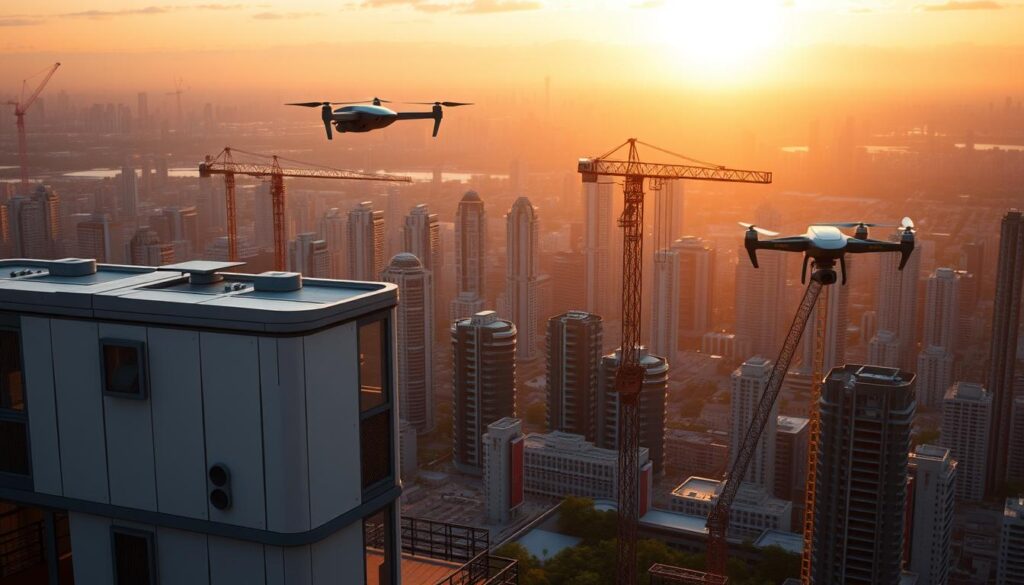
Smart Technologies and Automation
The integration of smart technologies and automation is set to revolutionize modular construction. By leveraging advanced software, IoT devices, and robotics, manufacturers can enhance efficiency, reduce labor costs, and improve quality control. For instance, automated systems can streamline the production process, minimizing errors and maximizing output.
The use of Building Information Modeling (BIM) is also becoming more prevalent, allowing for better project planning and management. BIM enables stakeholders to visualize the construction process, identify potential issues, and make informed decisions.
Eco-Friendly Materials
Sustainability is a growing concern in the construction industry, and modular construction is no exception. The use of eco-friendly materials is on the rise, driven by the need to reduce environmental impact. Modular builders are increasingly opting for materials that are recycled, recyclable, or sustainably sourced.
In addition to reducing waste, eco-friendly materials can also contribute to energy efficiency. For example, using materials with high thermal mass can help regulate building temperatures, reducing the need for heating and cooling.
Prefabrication Innovations
Prefabrication innovations are transforming the modular construction landscape. Advances in manufacturing technology have enabled the production of complex building components with high precision and accuracy. This not only improves the quality of the final product but also reduces on-site labor requirements.
The use of prefabricated modules is becoming more widespread, particularly in projects where time is of the essence. Prefabricated modules can be assembled quickly on-site, reducing construction timelines and minimizing disruptions to local communities.
As the modular construction industry continues to evolve, it is likely that we will see even more innovative applications of prefabrication technology. From entire building systems to individual components, prefabrication is set to play a major role in shaping the future of construction.
The Role of Technology in Modular Construction
The integration of technology in modular construction has revolutionized the industry. By leveraging advanced tools and techniques, modular construction companies can enhance efficiency, reduce costs, and improve overall quality.
Technology in modular construction encompasses a range of innovations, including Building Information Modeling (BIM), drones, and 3D printing. These technologies are transforming the way modular buildings are designed, constructed, and monitored.
Building Information Modeling (BIM)
BIM is a digital representation of the physical and functional characteristics of a building. It allows for detailed planning, design, and simulation, reducing errors and improving collaboration among stakeholders. By utilizing BIM, modular construction companies can optimize their processes and achieve better outcomes.
Drones and Site Monitoring
Drones equipped with cameras and sensors are being used to monitor construction sites, track progress, and identify potential issues. This technology enables real-time monitoring, improving site safety and reducing the need for physical inspections.
The use of drones in modular construction also facilitates the inspection of hard-to-reach areas, enhancing the overall efficiency of the construction process.
3D Printing in Modular Structures
3D printing is an emerging technology in modular construction, allowing for the rapid creation of complex building components. This technology can reduce material waste, lower labor costs, and improve the precision of construction elements.
As 3D printing technology continues to evolve, it is likely to play an increasingly important role in the modular construction industry, enabling the creation of innovative and sustainable buildings.
What is Modular Construction Engineering?
Modular construction engineering is revolutionizing the building industry with its innovative approaches. It involves the fabrication of modules in a controlled factory setting, which are then assembled on-site. This method minimizes weather-related delays and enables parallel on-site work, allowing for faster project completion and earlier occupancy.
Definition of Modular Construction
Modular construction refers to a construction technique where buildings are fabricated in a factory and then transported to the site for assembly. This prefabricated construction solution offers numerous benefits, including reduced construction time and improved quality control. According to a report by Viewpoint, modular construction can reduce project timelines by up to 50%.
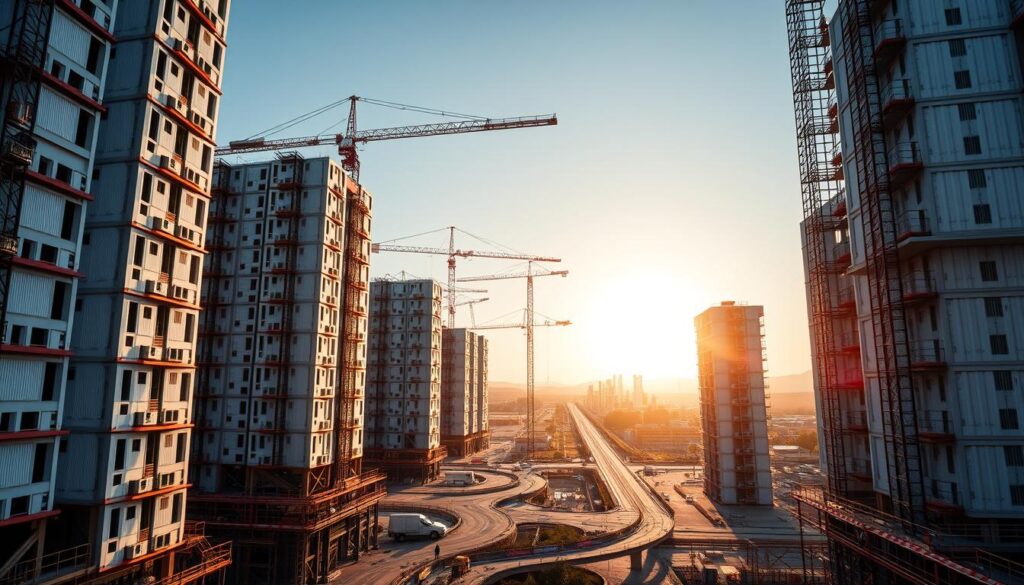
Key Elements of Modular Engineering
The key elements of modular engineering include modular building design, manufacturing, and assembly. Modular building design involves creating modules that can be easily transported and assembled on-site. Manufacturing takes place in a controlled factory environment, ensuring high-quality construction. Assembly on-site is typically faster than traditional construction methods.
| Key Elements | Description | Benefits |
|---|---|---|
| Modular Design | Involves creating modules for easy transport and assembly | Flexibility in design, faster assembly |
| Manufacturing | Takes place in a controlled factory environment | Improved quality control, reduced waste |
| Assembly | Faster on-site assembly compared to traditional methods | Reduced construction time, earlier occupancy |
In conclusion, modular construction engineering is a game-changer in the construction industry, offering numerous benefits such as cost-effectiveness, time efficiency, and sustainability. As the industry continues to evolve, embracing modular construction methods will be crucial for meeting future demands.
Benefits of Modular Construction Engineering
Modular construction engineering offers a multitude of benefits that are transforming the way we build. By leveraging standardized processes and materials, modular construction provides a more efficient and effective alternative to traditional construction methods.
Cost-Effectiveness
One of the primary advantages of modular construction is its cost-effectiveness. By manufacturing modules in a controlled factory environment, construction companies can reduce material waste and minimize the costs associated with on-site labor. This results in significant cost savings for clients.
Time Efficiency
Modular construction is also renowned for its time efficiency. By constructing modules simultaneously with site preparation, the overall construction timeline is significantly reduced. This enables projects to be completed faster, allowing for earlier occupancy and revenue generation.
Sustainability Practices
Modular construction promotes sustainability practices by reducing waste and minimizing the environmental impact of construction. The controlled factory environment allows for more efficient use of materials and energy, resulting in a more sustainable building process.
Flexibility in Design
Contrary to common misconceptions, modular construction offers flexibility in design. With the ability to customize modules to meet specific project requirements, architects and builders can create unique and innovative designs that might be challenging or impossible to achieve with traditional construction methods.
By embracing modular construction engineering, the construction industry can reap numerous benefits, from cost savings and reduced construction timelines to improved sustainability and design flexibility.
The Process of Modular Construction
The process of modular construction is multifaceted, involving careful planning, precise manufacturing, and efficient transportation. This complex process is what sets modular construction apart from traditional building methods, offering a streamlined and efficient approach to construction projects.
Planning and Design Stages
The initial stage of modular construction involves thorough planning and design. During this phase, architects and engineers work together to create detailed designs and models of the building. Building Information Modeling (BIM) is often utilized to enhance the design process, allowing for precise planning and identification of potential issues before construction begins.
The planning stage is crucial as it lays the foundation for the entire project. It involves not only the aesthetic design but also the structural integrity and functionality of the building. By leveraging advanced software and technologies, the planning and design stage ensures that the modular construction process is both efficient and effective.
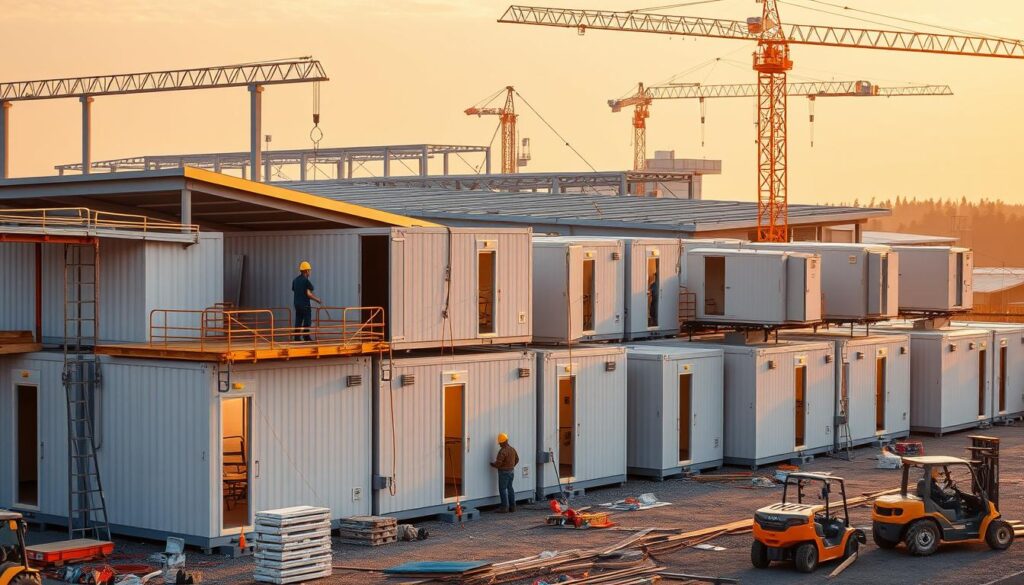
Manufacturing and Assembly
Once the design is finalized, the manufacturing stage begins. Modular units are constructed in a factory, where they are assembled with precision and care. This controlled environment allows for quality control measures to be implemented effectively, ensuring that each module meets the required standards.
The manufacturing process involves the fabrication of various components, including walls, floors, and roofs, which are then assembled into complete modules. These modules are designed to fit together seamlessly, allowing for quick assembly on-site.
| Stage | Description | Benefits |
|---|---|---|
| Planning and Design | Detailed designs and models created using BIM | Enhanced precision, early issue detection |
| Manufacturing and Assembly | Modules constructed in a factory | Quality control, efficient assembly |
| Transportation and Installation | Modules transported to site and installed | Quick on-site assembly, reduced construction time |
Transportation and Installation
After manufacturing, the modules are transported to the construction site. This stage requires careful planning to ensure that the modules are delivered on time and in good condition. Upon arrival, the modules are installed on the foundation, and the final connections are made.
The transportation and installation stage is critical to the overall success of the project. It involves not only the physical placement of the modules but also ensuring that all necessary utilities and connections are properly established.
By following this process, modular construction projects can be completed efficiently, with minimal disruption to the surrounding environment. The end result is a high-quality building that meets the needs of its occupants, delivered in a timely and cost-effective manner.
Key Players in Modular Construction
The modular construction industry is witnessing significant growth, driven by leading companies and innovative startups that are pushing the boundaries of modular design and construction. Companies like EVstudio and Innovative Building Solutions are at the forefront of this revolution, introducing new technologies and methodologies that are transforming the industry.
Leading Companies in the Industry
Several leading companies are making significant contributions to modular construction. These companies have extensive experience and expertise in designing and building modular structures. Some of the notable companies include:
- EVstudio
- Innovative Building Solutions
- Other prominent companies that are leveraging modular construction techniques to deliver high-quality projects.
Innovative Startups to Watch
The modular construction landscape is also being shaped by innovative startups that are bringing fresh perspectives and new ideas to the table. These startups are often at the forefront of technological innovation, developing cutting-edge solutions that enhance the efficiency and sustainability of modular construction. For more information on notable companies in the civil engineering sector, you can visit this link.
Notable Projects and Case Studies
Several notable projects and case studies highlight the potential of modular construction. These projects demonstrate the versatility and benefits of modular construction, from residential buildings to commercial spaces and infrastructure projects.
| Project Name | Location | Description |
|---|---|---|
| Modular Housing Project | New York | A residential complex built using modular construction techniques, showcasing speed and quality. |
| Commercial Modular Office | California | A commercial office space constructed using modular methods, highlighting flexibility and sustainability. |
| Modular School Building | Texas | An educational institution built using modular construction, demonstrating the potential for rapid deployment. |
The table above illustrates a few examples of successful modular construction projects. These case studies provide valuable insights into the benefits and challenges of modular construction, serving as a reference for future projects.
Types of Modular Construction
The versatility of modular construction is reflected in its various types, including permanent, relocatable, and hybrid solutions. Each type is designed to meet specific needs and offers unique advantages.
Permanent Modular Buildings
Permanent modular buildings are constructed in a factory and then assembled on-site to create a permanent structure. These buildings are designed to be durable and long-lasting, meeting local building codes and regulations. Permanent modular buildings are often used for residential, commercial, and educational facilities.
The advantages of permanent modular buildings include reduced construction time, improved quality control, and enhanced sustainability. They are also cost-effective, as they minimize on-site labor and reduce waste.
Relocatable Modular Structures
Relocatable modular structures are designed to be easily disassembled and relocated as needed. These structures are ideal for temporary or seasonal use, such as during events or in areas with changing needs. Relocatable modular structures offer flexibility and can be reused multiple times, reducing the need for new construction materials.
The benefits of relocatable modular structures include their adaptability, cost-effectiveness, and environmental sustainability. They can be easily modified or expanded to meet changing requirements.
Hybrid Modular Solutions
Hybrid modular solutions combine elements of both permanent and relocatable modular construction. These solutions offer the benefits of modular construction while allowing for flexibility in design and application. Hybrid modular solutions are used in a variety of projects, from residential to commercial and industrial developments.
The advantages of hybrid modular solutions include their versatility, sustainability, and cost-effectiveness. They can be tailored to meet specific project requirements, making them an attractive option for developers and builders.
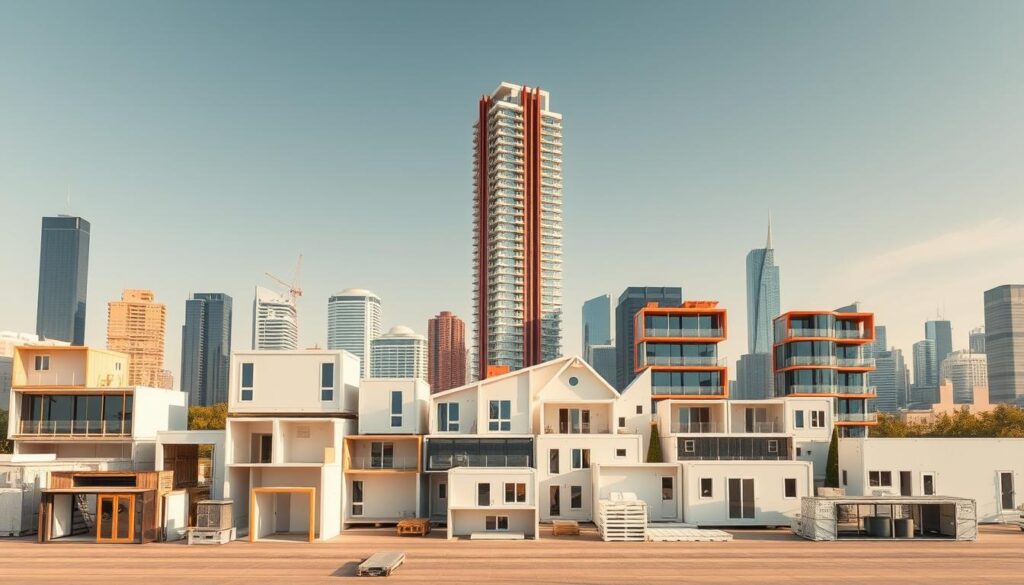
Modular Construction vs. Traditional Construction
Modular construction is revolutionizing the building industry by offering a faster, more efficient alternative to traditional construction methods. This modern approach to building has gained significant attention in recent years due to its numerous benefits.
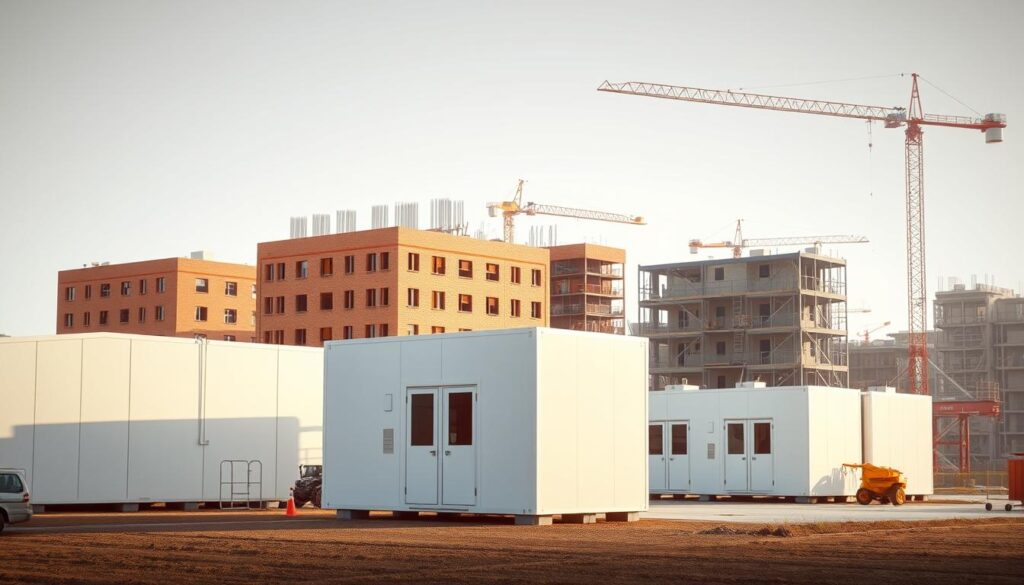
Speed of Construction
One of the primary advantages of modular construction is its ability to significantly reduce construction time. By manufacturing modules in a controlled factory environment, the construction process can be accelerated, allowing projects to be completed up to 50% faster than traditional methods.
This speed is particularly beneficial for projects with tight deadlines or those that require rapid deployment, such as disaster relief housing or temporary facilities.
Quality Control
Modular construction also excels in terms of quality control. The factory-based manufacturing process allows for rigorous quality checks at every stage, ensuring that the final product meets high standards.
Additionally, the controlled environment minimizes the risk of weather-related damage or site theft, further enhancing the overall quality of the construction.
For more information on sustainable building materials often used in modular construction, visit https://worldcivilsociety.com/sustainable-building-materials/.
Environmental Impact
The environmental impact of modular construction is another area where it outperforms traditional methods. By minimizing on-site waste and optimizing material usage, modular construction reduces its ecological footprint.
Furthermore, the use of eco-friendly materials and practices in modular construction contributes to a more sustainable building process, aligning with the growing demand for environmentally responsible construction practices.
In conclusion, the comparison between modular construction and traditional construction highlights the advantages of adopting modular methods, including faster construction times, improved quality control, and reduced environmental impact.
Applications of Modular Construction Engineering
Modular construction engineering has revolutionized the building industry with its diverse applications. This innovative method is being utilized across various sectors, providing efficient and flexible solutions for different building needs.
Residential Buildings
Modular construction is increasingly being used in residential buildings due to its speed, quality, and cost-effectiveness. Modular homes are built in a factory, reducing on-site construction time and minimizing environmental impact. According to a report by the Modular Building Institute, modular residential construction can reduce construction time by up to 50%.
For instance, a modular residential project in the United States was completed in just 12 weeks, whereas traditional construction would have taken over 6 months. This rapid construction capability is particularly beneficial in addressing housing shortages.
Commercial Spaces
Commercial spaces, such as office buildings and retail stores, are also benefiting from modular construction. The method allows for flexible design options and quick turnaround times, making it ideal for businesses looking to establish or expand their presence quickly.
A notable example is a modular office building in a major city, which was completed in just a few months. This rapid completion allowed the company to start operations sooner, thereby improving their market position.
Healthcare Facilities
Modular construction is being used to build healthcare facilities, including hospitals and clinics. The precision and quality control in modular construction are particularly important in healthcare, where facilities must meet stringent health and safety standards.
“Modular construction allows us to deliver high-quality healthcare facilities quickly and efficiently, which is critical in meeting the healthcare needs of our communities.” – John Smith, CEO of a leading healthcare construction company.
Educational Institutions
Educational institutions, such as schools and universities, are turning to modular construction to address their infrastructure needs. Modular buildings can be used for classrooms, administrative offices, and other facilities, providing a quick and efficient solution.
| Application | Benefits |
|---|---|
| Residential Buildings | Speed, quality, cost-effectiveness |
| Commercial Spaces | Flexible design, quick turnaround |
| Healthcare Facilities | Precision, quality control, meeting health and safety standards |
| Educational Institutions | Quick and efficient solution for infrastructure needs |
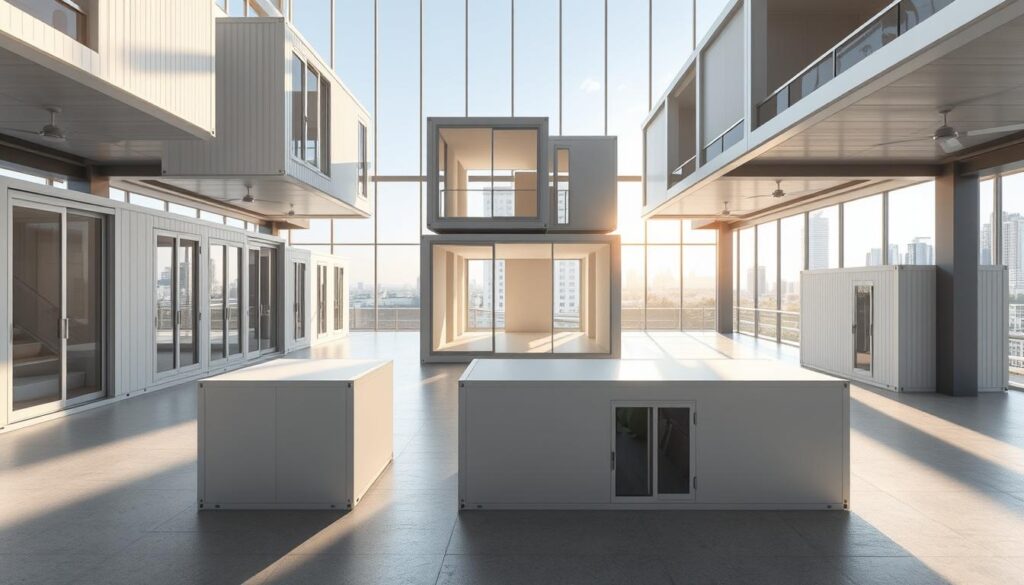
In conclusion, modular construction engineering has a wide range of applications across different sectors, including residential buildings, commercial spaces, healthcare facilities, and educational institutions. Its benefits, such as speed, quality, and cost-effectiveness, make it an attractive solution for various building needs.
Challenges in Modular Construction
Modular construction, despite its numerous benefits, faces several challenges that need to be addressed for its continued growth. The industry encounters various obstacles that can impact the successful completion of projects.
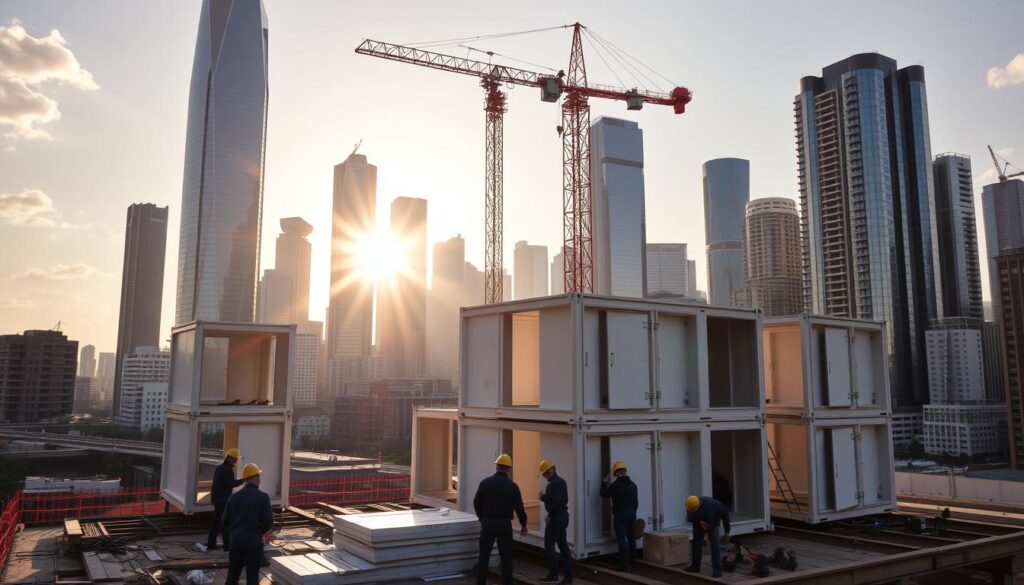
Regulatory Issues
One of the significant challenges in modular construction is navigating regulatory issues. Building codes and zoning regulations vary by location, and modular construction must comply with these regulations, which can be complex and time-consuming.
To address regulatory issues, it’s essential to work closely with local authorities and ensure that all modular construction projects meet the necessary standards and codes.
Logistics and Transportation
Logistics and transportation are critical components of modular construction, as modules are typically manufactured in a factory and then transported to the construction site. Coordination between manufacturers, transporters, and site managers is crucial to ensure timely delivery and installation.
Challenges in logistics and transportation can lead to delays and increased costs. To mitigate these risks, companies can invest in advanced logistics planning and management systems.
Design Limitations
Design limitations are another challenge faced by the modular construction industry. While modular construction offers flexibility in design, there are limitations to the size and complexity of modules that can be manufactured and transported.
To overcome design limitations, architects and engineers are working together to develop innovative design solutions that maximize the potential of modular construction while minimizing constraints.
Future Trends in Modular Construction
Modular construction is evolving rapidly, with future trends indicating a shift towards more efficient, sustainable, and innovative building practices. The industry is expected to be shaped by several key factors, including technological advancements, environmental concerns, and changing consumer demands.
Smart Technologies and Automation
The integration of smart technologies and automation is set to revolutionize modular construction. This includes the use of Building Information Modeling (BIM), drones for site monitoring, and automated manufacturing processes. These technologies enhance precision, reduce labor costs, and improve project timelines.
For instance, the use of BIM allows for detailed planning and simulation, reducing errors and improving collaboration among stakeholders. Similarly, drones enable real-time monitoring of construction sites, enhancing safety and facilitating prompt issue resolution.
Eco-Friendly Materials
The future of modular construction is also closely tied to the adoption of eco-friendly materials. As sustainability becomes a growing concern, the industry is shifting towards materials that are recycled, recyclable, or sustainably sourced. This not only reduces the environmental footprint of construction projects but also enhances their appeal to eco-conscious consumers.
A notable example is the use of cross-laminated timber (CLT), a sustainable alternative to traditional building materials. CLT offers several benefits, including reduced carbon emissions, improved thermal performance, and enhanced aesthetic appeal.
Prefabrication Innovations
Prefabrication innovations are another key trend shaping the future of modular construction. Advances in manufacturing technology have enabled the production of complex building components off-site, which can then be assembled on-site. This approach reduces waste, improves quality control, and accelerates project completion.
| Innovation | Description | Benefits |
|---|---|---|
| Modular Building Systems | Pre-engineered modules that can be easily assembled | Reduced construction time, improved quality |
| Prefabricated Wall Panels | Pre-assembled wall panels with integrated electrical and plumbing systems | Enhanced efficiency, reduced on-site labor |
| 3D Printing Technology | Use of 3D printing to create complex building components | Increased precision, reduced material waste |
As the modular construction industry continues to evolve, it is likely that we will see further innovations in prefabrication, leading to even more efficient and sustainable building practices.

The Role of Technology in Modular Construction
Technology plays a vital role in enhancing the efficiency and quality of modular construction projects. The integration of advanced technologies has transformed the way modular buildings are designed, constructed, and monitored.
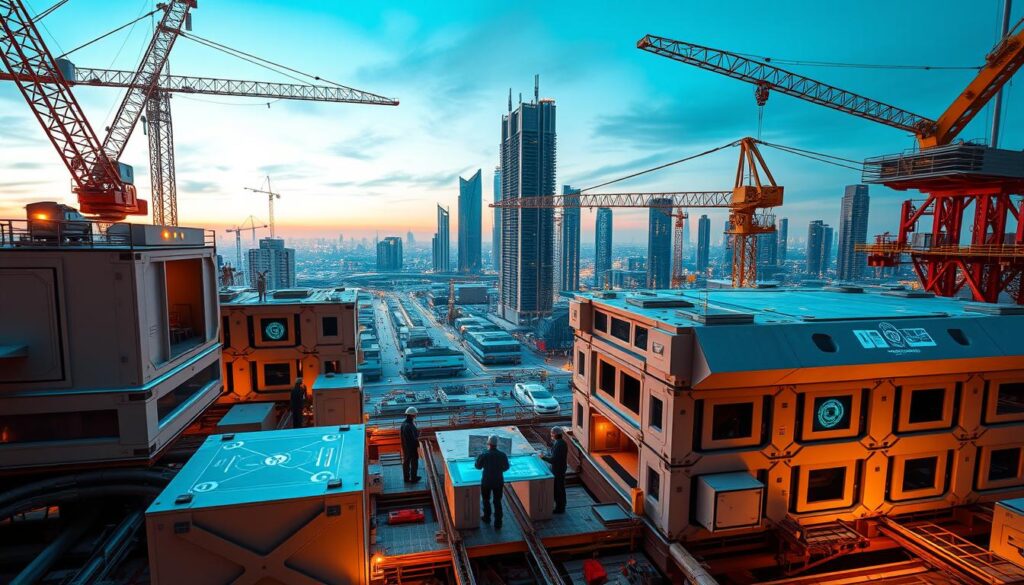
Building Information Modeling (BIM)
BIM is a digital representation of the physical and functional characteristics of a building. It enables architects, engineers, and contractors to collaborate more effectively, reducing errors and improving project outcomes. In modular construction, BIM facilitates the design and manufacturing process by providing detailed models that can be used to manufacture modules accurately.
Drones and Site Monitoring
Drones equipped with cameras and sensors are used for site monitoring, providing real-time data on construction progress. This technology helps in identifying potential issues early, improving site safety, and reducing the need for physical inspections. Drones can capture detailed images and videos, enabling project managers to track progress and make informed decisions.
3D Printing in Modular Structures
3D printing is an innovative technology that is being increasingly used in modular construction. It allows for the creation of complex building components with high precision and speed. 3D printing can reduce material waste and labor costs, making it a sustainable and efficient solution for modular construction projects.
The use of these technologies in modular construction is expected to continue growing, driving innovation and improvement in the industry. As technology advances, we can expect to see even more sophisticated applications in the field.
Modular Construction in Urban Development
The integration of modular construction in urban development is addressing critical issues such as housing shortages and infrastructure strain. As cities continue to expand, the demand for efficient, sustainable, and cost-effective building solutions has never been higher.
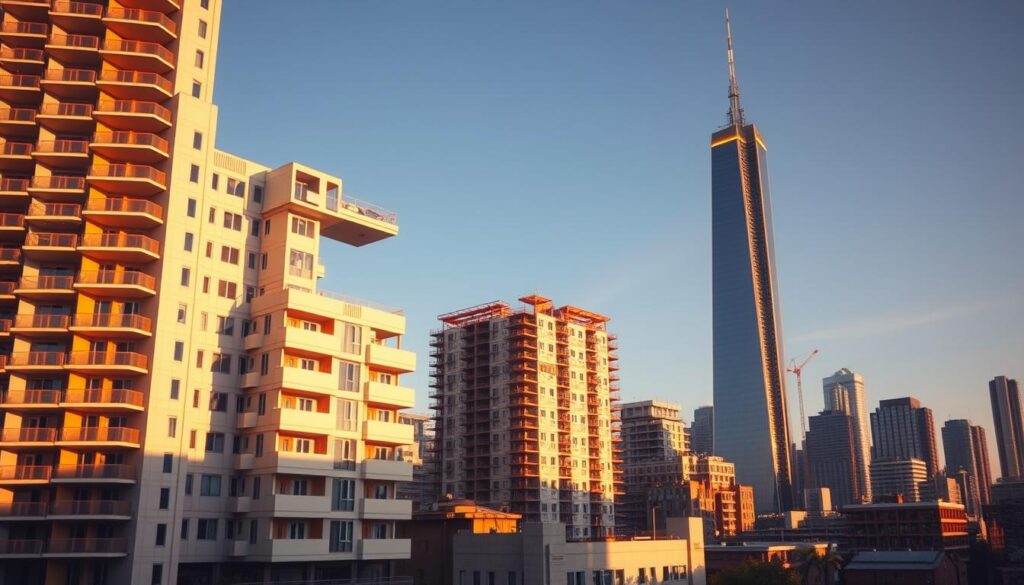
Meeting Housing Needs
Modular construction is significantly contributing to meeting the housing needs in urban areas. By enabling the rapid production of high-quality housing units, modular construction helps to alleviate housing shortages. The benefits include:
- Speed: Modular construction reduces the overall construction time, allowing for quicker occupancy.
- Quality: Factory-controlled environments ensure higher quality and fewer defects.
- Affordability: Reduced construction time and improved quality translate into cost savings.
Addressing Infrastructure Challenges
Urban infrastructure is under constant strain due to population growth. Modular construction offers a viable solution by providing:
- Innovative designs that can be adapted for various infrastructure needs, such as bridges and tunnels.
- Efficient manufacturing processes that minimize environmental impact.
- Flexibility in design and implementation, allowing for easier upgrades and modifications.
Enhancing Urban Resilience
Modular construction also plays a crucial role in enhancing urban resilience. By incorporating sustainable materials and practices, modular buildings can contribute to:
- Energy efficiency: Modular buildings can be designed with energy-efficient systems.
- Disaster resilience: Modular structures can be engineered to withstand natural disasters.
- Sustainable practices: The use of eco-friendly materials and waste reduction strategies.
In conclusion, modular construction is a vital component of modern urban development, offering solutions to housing shortages, infrastructure challenges, and sustainability concerns. As the world continues to urbanize, the role of modular construction is likely to become even more significant.
The Economic Impact of Modular Construction
Modular construction has emerged as a game-changer in the building sector, offering substantial economic benefits. This innovative approach to construction is not only transforming the way buildings are designed and constructed but also having a significant impact on the economy.
The economic benefits of modular construction are multifaceted, ranging from job creation to cost savings for clients. As the industry continues to grow, it’s essential to understand the various ways in which modular construction is influencing the economy.
Job Creation in the Industry
One of the most significant economic benefits of modular construction is the creation of new job opportunities. As the demand for modular buildings increases, manufacturers are hiring more workers to meet the demand. According to a report by McKinsey, the modular construction industry is creating new jobs in manufacturing, transportation, and installation.
The job creation is not limited to the manufacturing process alone; it also extends to the design and planning stages. Architects, engineers, and project managers are needed to oversee the construction process, ensuring that the modular buildings meet the required standards and specifications.
| Job Category | Number of Jobs Created | Percentage Increase |
|---|---|---|
| Manufacturing | 10,000 | 15% |
| Transportation | 2,000 | 10% |
| Installation | 3,000 | 12% |
Effects on Local Economies
Modular construction is also having a positive impact on local economies. By investing in local manufacturing facilities, modular construction companies are contributing to the local economy. The increased economic activity is generating revenue for local governments through taxes and creating new opportunities for local businesses.
Furthermore, modular construction is often associated with reduced construction timelines, which means that buildings are completed faster, and occupants can start using them sooner. This rapid completion can lead to increased economic activity in the surrounding area, as businesses and residents move in and start operating.
Cost Savings for Clients
In addition to job creation and local economic growth, modular construction is also providing cost savings for clients. The streamlined manufacturing process and reduced waste contribute to lower construction costs. Moreover, the predictability of modular construction costs allows clients to budget more effectively.
According to industry reports, modular construction can result in cost savings of up to 20% compared to traditional construction methods. This is a significant advantage, especially for large-scale projects where cost control is crucial.
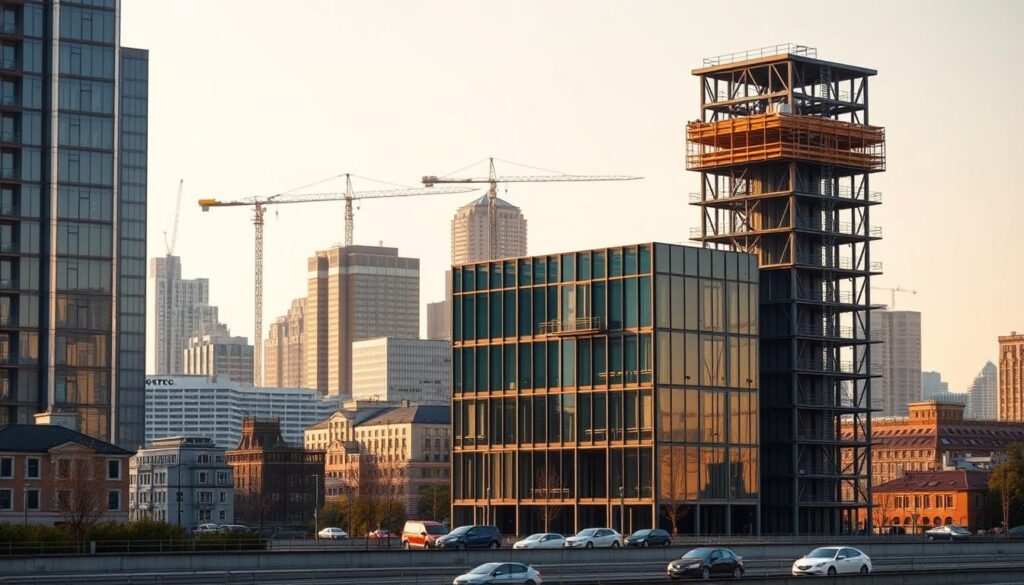
Steps to Get Started with Modular Construction
Embarking on a modular construction project requires careful planning and research to ensure success. Modular construction offers a range of benefits, including cost-effectiveness, time efficiency, and sustainability practices. To capitalize on these advantages, it’s essential to understand the steps involved in getting started.
Researching Your Options
The first step in getting started with modular construction is to research your options. This involves understanding the different types of modular construction, such as permanent modular buildings, relocatable modular structures, and hybrid modular solutions. By researching your options, you can determine which type of modular construction best suits your needs.
According to industry experts, “Research is key to understanding the modular construction process and identifying the right modular builder for your project.” Learn more about the modular construction.
Choosing the Right Modular Builder
Choosing the right modular builder is a critical step in the modular construction process. A reputable modular builder can ensure that your project is completed on time, within budget, and to the required quality standards. When selecting a modular builder, consider factors such as their experience, reputation, and portfolio of previous projects.
- Look for modular builders with a proven track record of delivering successful projects.
- Check for industry certifications and compliance with regulatory requirements.
- Assess their ability to customize modular solutions to meet your specific needs.
Understanding Project Financing
Understanding project financing is another crucial aspect of getting started with modular construction. Modular construction projects can offer significant cost savings compared to traditional construction methods. However, it’s essential to understand the financing options available and how to structure your project to maximize these savings.
Key considerations for project financing include:
- Exploring financing options, such as loans and grants, specifically designed for modular construction projects.
- Understanding the impact of modular construction on your project’s overall budget and cash flow.
- Assessing the potential return on investment (ROI) for your modular construction project.
By carefully researching your options, choosing the right modular builder, and understanding project financing, you can set your modular construction project up for success.
Case Studies: Successful Modular Projects
The effectiveness of modular construction is highlighted through various case studies of successful projects. These examples demonstrate the versatility and benefits of modular construction in different applications.
High-Rise Modular Developments
High-rise modular developments are pushing the boundaries of what is possible with modular construction. For instance, the Acumen Apartments in New York City, a 32-story building, was constructed using modular techniques, significantly reducing the construction time. Such projects showcase the potential for modular construction in urban development.
These high-rise developments benefit from the precision and quality control of modular construction, resulting in structures that are not only faster to build but also meet high standards of quality and safety.
Disaster Relief Housing
Modular construction is also being utilized for disaster relief housing, providing quick and efficient solutions for temporary housing needs. After natural disasters, modular units can be rapidly deployed to affected areas, offering shelter to those in need.
Organizations like Habitat for Humanity have used modular construction to deliver disaster relief housing, demonstrating the method’s potential for humanitarian applications.
Community Development Initiatives
Community development initiatives are another area where modular construction is making a significant impact. Modular buildings are being used for community centers, schools, and other public facilities, enhancing local infrastructure.
For example, the Modular Classroom Project in California involved the construction of modular classrooms for schools, providing additional learning spaces while minimizing disruption to the educational process.
These case studies illustrate the diverse applications and benefits of modular construction, from high-rise developments to community initiatives. As the industry continues to evolve, it is likely that we will see even more innovative uses of modular construction in the future.
Conclusion: Embracing Modular Construction Engineering
Modular construction engineering is revolutionizing the building industry with its innovative solutions and sustainable practices. As discussed, this method offers numerous benefits, including cost-effectiveness, time efficiency, and flexibility in design.
Key Takeaways
The key advantages of modular construction include reduced construction time, improved quality control, and minimized environmental impact. This method is being successfully applied in various sectors, from residential buildings to healthcare facilities and educational institutions.
Future Innovations
As the industry continues to evolve, future innovations in modular construction are expected to drive further growth. The integration of smart technologies, eco-friendly materials, and advanced prefabrication techniques will be crucial in shaping the future of modular construction engineering.
In conclusion, modular construction engineering holds significant promise for the future of the construction industry. By embracing this innovative approach, we can create more sustainable, efficient, and adaptable building solutions, ultimately enhancing the way we build and interact with our built environment.
